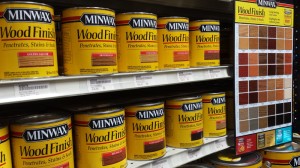Wood Stain
A wood stain is defined as colorant suspended or dissolved in an agent or solvent. The agent can be water, alcohol, petroleum distillate, or another finishing product (i.e. Shellac, polyurethane, varnish, etc).
Pigments and dyes are usually the colorant agent that is used. The difference between the  two is the size of the particles. Dyes are microscopic crystals that dissolve in the suspension agent. This makes dyes ideal for colouring very fine grained woods. Pigments have a larger crystal and are not able to bind themselves to the very fine grained woods. Pigments will also not give much color to dense woods, but are suited for woods with large pores, i.e. pine.
two is the size of the particles. Dyes are microscopic crystals that dissolve in the suspension agent. This makes dyes ideal for colouring very fine grained woods. Pigments have a larger crystal and are not able to bind themselves to the very fine grained woods. Pigments will also not give much color to dense woods, but are suited for woods with large pores, i.e. pine.
Most commercial stains available today contain both pigments and dyes. The degree in which they stain wood is dependent on how long it is left on the wood. The goal of wood stain is to color the substrate of the wood well still maintaining the visibility of the substrate.
Stains can be broken up into four different categories that describe how the stain coats the wood.
Clear Toner Stains contain fine ground iron pigments called transoxides. These pigments block the sun without obscuring the woods grain while leaving a slight warm tint. The stain leaves no film and can’t peel.
Semi transparent Stains contain enough pigment to change the color of the wood substrate, but not enough to obscure its grain. It leaves no film and can’t peel.
Semi solid Stains has more pigments than semi transparent stains. Because of the extra pigments the stain partially obscured the wood grain. It does not form a film and can’t peel.
Solid Color Stains look like flat paint. Of all the stains they have the most pigments in them. This stain hides the woods grain but not its texture. It does form a film and can peel if not applied properly.
Another thing to consider with stain is what the carrier medium of the pigment and dyes will be. This area can be broken up into eight different types of stains.
- Oil Stain
- Varnish Stain
- Water Based Stain
- Gel Stain
- Lacquer Stain
- Water Soluble Dye Stain
- Metal Complex Dye Stain
- Homemade Stain
Click on one to learn more!
